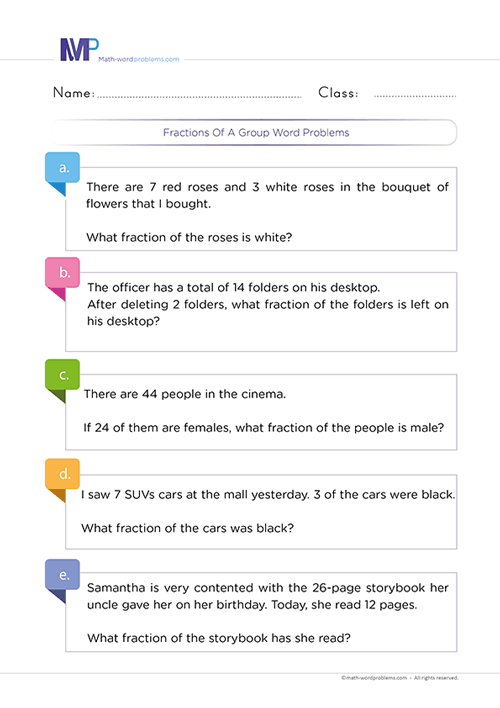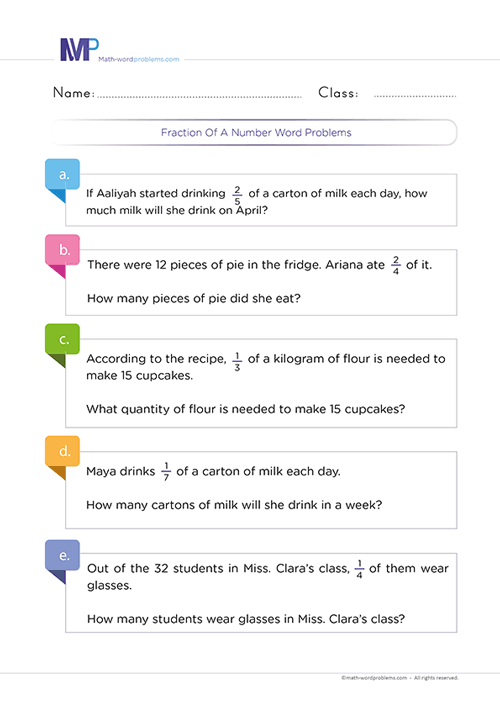 The best strategy for solving fractions of a whole-word problem
The best strategy for solving fractions of a whole-word problem
This resource focuses on the best strategy for solving fractions of a whole-word problem. We want to enhance kids' fraction skills by providing simple strategies and step-by-step solving guides. Most importantly, we will provide concrete and visual representations, explicit statements, systematic instructions, sequences, interesting real-life examples, and the best strategy for solving fractions of a whole-word problem.
However, this resource is all about evidence-based instructional components that will bring out kids' potential to tackle word problems involving fractions of a whole efficiently.
Steps to solve fractions of a whole word problem
These unique steps to solve fractions of a whole word problem are so straightforward that kids will understand and be more motivated to learn other concepts of fractions like mixed fractions, fractions in recipes, and many more. In addition, these outstanding steps will allow kids to master critical concepts quickly, helping to facilitate the learning of more advanced mathematical ideas of fractions of a whole word problem.
We have noticed that 3rd Graders struggle to master steps and strategies for solving fractions of a whole-word problem. For this reason, the following real-life problems will guide them on how magical these unique steps work.
Step 1 IDENTIFY THE PROBLEM:
To identify the problem,
- begin by studying/reading out the problem carefully to understand
- Then, identify and highlight relative statements.
- Now, reread the problem and try to find out important numbers and keywords in the problem.
For instance, the only common keyword you need to look out for in fractions of a whole is “What fraction of.” Equally, find out if the word problem consists of a part and a whole.
***Note: learners should understand that it would be best not to rely entirely on keywords alone because a particular keyword can have different meanings in different word problems.
In that case, you need to read the question very well to understand the situation that the word problem is describing. After reading, you will also find out if the problem makes sense first before determining which operation you need to use.***
Step 2 STRATEGIZE AND DETERMINE THE OPERATIONS:
As you move on to this step, ask yourself this pertinent question because it helps, “how am I going to handle this problem?”
Here, you will apply the read-to-understand rule. i.e., you have to read the word problem and try to interpret it in your own words.
Also, since each word problem may require a different solving format, the key points below will help you to tackle any word problem irrespective of the format.
- First, the keyword(s) in the word problem will help clarify the operation you need to carry out.
- Although relying on keywords alone to solve word problems has some limits,
- you must first read the word problem to understand the situation that the problem is describing. Reading the problem to understand will lead you to be able to identify the problem type and relative statements in the word problem, which, together with the keyword(s) in the problem, will determine the correct maths operation that you need to use
However, to grasp fractions of a whole quickly, you’ll have to understand some primary language used in fractions like:
- Part, also known as the numerator, is the top number in a fraction. The numerator says how many pieces we are dealing with.
- The whole, also known as the denominator, is the bottom of a fraction. The denominator describes the size of the pieces.
Step 3 SET UP A NUMBER SENTENCE AND AN EQUATION:
- After knowing which operation you will perform, construct short sentences to represent the information given in the word problem.
- These short sentences represent the vital information that makes it easier to solve the word problem. In order words, it is like a diagram of the word problem.
- In addition, use “/” to separate the numerator from the denominator.
Step 4 SOLVE THE PROBLEM:
From Step 3 above, simplify the fraction if need be. In addition to this, always recall adding the unit of measurement to your final answer.
Step 5 VERIFY YOUR ANSWER:
Finally, check your work to make sure that your answer is correct. For instance, since you are dealing with only numbers and not algebraic expressions, it is good to use reasonableness by estimation to see if your answer makes sense.
Therefore, if you estimate and the answer is close to what you have, your answer is correct. However, if your answer is beyond reasonable limits, you must go back to step one and start again.
Examples of how to solve fractions of a whole word problem
Example One
Step 1:Read the problem and underline all the relational statements. So, after reading the problem very well, you’ll come across the important numbers, i.e., 12, 5, and 3. The keyword found in the word problem is “what fraction of” and “left. “
Step 2:
Now, the question is, how will you solve this problem? Which is the whole, and which is the part?
At this stage, you need to reread the problem and interpret it in your own words to come out with the correct operation without necessarily depending on the keyword.
The problem is trying to say that the two siblings love cake a lot. So, on one of the siblings’ birthdays, their mother baked cake and cut it into a certain number of equal pieces. The birthday sibling ate a certain number of pieces of the cake, and the other sibling ate some as well.
Now, the problem wants you to find the fraction of the cake that was left.
Now, “which operation can I use to find the parts of a whole?”
Back to the given problem, the part is the number of pieces of cake left, and the whole is the number of pieces the cake is divided into.
So, from the situation that the problem is describing, from retelling the problem in your own words, and from the keyword equally found in the word problem, it shows that it is a fraction of a whole problem.
Also, the keyword “left” is trying to tell you that you must perform a subtraction operation at some point.
Step 3:Next, construct short sentences representing the most vital information in the word problem.
Now, after knowing what the part (numerator) and the whole (denominator) will be, you need to translate the sentence in bold below into an accurate, solvable math equation.
Also, use “/” to separate the numerator from the denominator.
- Pieces of cake James ate = 3
- Pieces of the cake the birthday girl ate = 5
- Total pieces of the cake they both ate = 3 + 5 = 8
- The total number of pieces the cake was divided into = 12
- Pieces of the cake left = the total number of pieces the cake was divided into - the total pieces of the cake they both ate
→ 12 – 8 = 4
- Therefore, the fraction of the cake left = pieces of the cake left as the numerator, and the total number of pieces the cake was divided into as the denominator.
Step 4: From Step 3 above, simplify the fraction if necessary. In addition, always recall to include the unit of measurement in the final result.
So,
Step 5: Finally, check your work to ensure your answer is correct. Since you are dealing with only numbers and not algebraic expressions, it is good to use reasonableness by estimation to see if your answer makes sense.
So, if you estimate and the answer is close to the one you have, then your answer is correct. However, if your answer is beyond reasonable limits, you must go back to step one and start again.
Example Two
Step 1: Now, the question is, how will you solve this problem? Which is the whole, and which is the part?
Step 2:At this moment, how will you tackle the problem? From the situation that the problem is describing and the keywords found in the word problem, it implies that you have to perform a multiplication operation.
At this stage, you need to reread the problem and interpret it in your own words to come out with the correct operation without necessarily depending on the keyword.
The problem is trying to say that Charles divided the pizza he had for lunch into a certain number of equal pieces. He put cheese in some pieces and microwaved them.
Now, the problem needs you to find the fraction of the pizza; he did not add cheese on.
Now, “which operation can I use to find the parts of a whole?”
In the problem, the part is the number of pieces of pizza he did not add cheese, and the whole is the number of pieces he divided the pizza into.
So, from the situation that the problem is describing, from retelling the problem in your own words, and from the keyword equally found in the word problem, it shows that it is a fraction of a whole problem.
Step 3:Next, construct short sentences representing the most vital information in the word problem.
Now, after knowing what the part (numerator) and the whole (denominator) will be, you need to translate the sentence in bold below into an accurate, solvable math equation.
Also, use “/” to separate the numerator from the denominator.
- Pieces of pizza he added cheese on = 2
- Total number of pieces he divided the pizza into = 6
- pieces of pizza he did not add cheese on = the total number of pieces he divided the pizza into - the pieces of pizza he added cheese on
6 – 2 = 4
- Therefore, the fraction of the pizza he did not add cheese on = the pieces of pizza he did not add cheese on as the numerator and the total number of pieces he divided the pizza into as the denominator.
= ?
Step 4: From step 3, simplify the fraction if necessary. In addition, always recall to include the unit of measurement in the final result.
So, he did not add cheese on
Step 5: Finally, check your work to ensure your answer is correct. Since you are dealing with only numbers and not algebraic expressions, it is good to use reasonableness by estimation to see if your answer makes sense.
So, if you estimate and the answer is close to the one you have, then your answer is correct. However, if your answer is beyond reasonable limits, you must go back to step one and start again.






